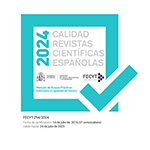Guía interpretativa de los motivos simbólicos de Homo faber
Abstract
This article is an attempt to present an exhaustive and interpretative guide to the many symbolic aspects in Max Frisch’s HOMO FABER. Although some of these symbols are very evident, others are not, and demand a very good knowledge of the Greek culture and a solid interpretation to reach the deep level of the novel. With this work we hope that the common cultivated reader might achieve an integral reading of the novel on its many levels. First we analyze the symbolic use of TIME and its many mergings with the meaning and the formal structure of the novel: Faber’s travels, the analepses and prolepses, their use and meaning. Afterwards we proceed to a counting and detailed analysis of the many symbolic aspects of the novel in connection with the Greek world —aspects that allow and confirm the possible interpretation of the novel as a modern Greek tragedy about destiny— beginning with the masculine mythological figures hiding under the main protagonist Faber (Ulisses, Agamenon, Edipus, etc.), and ending with topics such as blindness, Greek art, the placenames, etc. We also analyze the symbolic topics in relation with nature (the moon eclipse, etc.), the physical and psychological sensations (like cold and heat, trembling, etc.) and we conclude with an analysis of the symbolic value of colours (red and black) in the novel.Downloads
##submission.format##
Licenza
La Revista de Filología Alemana, para fomentar el intercambio global del conocimiento, facilita el acceso sin restricciones a sus contenidos desde el momento de su publicación en la presente edición electrónica, y por eso es una revista de acceso abierto. Los originales publicados en esta revista son propiedad de la Universidad Complutense de Madrid y es obligatorio citar su procedencia en cualquier reproducción total o parcial. Todos los contenidos se distribuyen bajo una licencia de uso y distribución Creative Commons Reconocimiento 4.0 (CC BY 4.0). Esta circunstancia ha de hacerse constar expresamente de esta forma cuando sea necesario. Puede consultar la versión informativa y el texto legal de la licencia.










